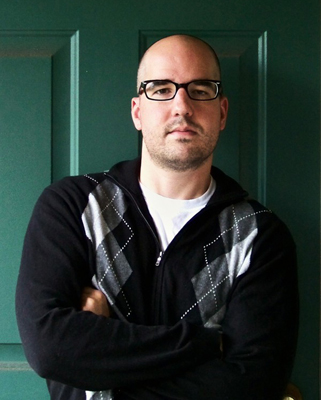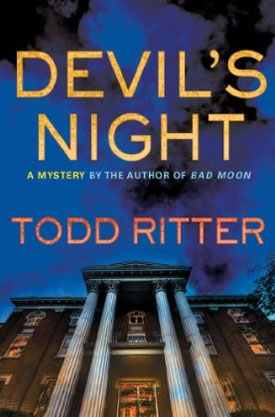Fire On My Mind by Todd Ritter
 Story ideas can be a pain in the ass.
Story ideas can be a pain in the ass.
Most aren’t. Most pop into a writer’s head, rattle around there for a day or so and then vanish just as quickly as they appeared. Those are whims, not ideas — as thin and impermanent as clouds.
But then there are the real ideas. The aforementioned pain-in-the-ass ones. They refuse to go away, sometimes resurfacing weeks, months, even years after they first arrived. The idea behind DEVIL’S NIGHT, the third book in my Kat Campbell mystery series, was one of those. In fact, I’ve been carrying it with me for going on thirty years.
In DEVIL’S NIGHT, the small town of Perry Hollow, Pa., is terrorized by a series of arsons on Halloween. And the idea for it first took hold of me when I was at the ripe old age of nine. That was the year the general store in the tiny village where I grew up burnt to the ground on Halloween night.
I don’t know why the fire spooked me, but it did. It might have been because fires were a rare occurrence during my sheltered childhood, as dangerously exotic as, say, an avalanche or tornado. Is also could have been due to the fact that my school bus rumbled past that store every day, which, to a kid, suggested some sort of kinship and familiarity. Most likely, though, the blaze unnerved me because of when it took place. A fire on Halloween felt ominous and vaguely sinister to a nine-year-old with an overactive imagination. It conjured up thoughts of demons and devil’s and witches. I didn’t know it back then, but the idea for DEVIL’S NIGHT was born.
Fast-forward a few years, to the late eighties. There were more fires in the news, taking place in a town not so very far from mine. I honestly can’t remember the time of year, nor can I remember the town. But I vividly recall reading newspaper accounts of a Pennsylvania town that had seen a large number of arsons in a frighteningly short amount of time. Memories of that Halloween blaze, now mostly forgotten, came roaring back and I realized that a combination of the two — a series of arsons and Halloween — would make a pretty nifty book or movie, if someone decided to do such a thing. At the time, writing books was not on my to-do list.
Let’s fast-forward again. Almost fifteen years this time. The year was 2002 and, stinging from the sound rejection of my first (and still-unpublished) thriller, I decided to write a screenplay. The first idea that popped into my head was — you guessed it — a story about a mad arsonist setting fire to a small town during Halloween. I decided to set it in Salem, Mass., just to get the prospect of witchcraft involved. I envisioned it as a cross between Backdraft and Halloween. The title was, coincidentally enough, DEVIL’S NIGHT.
 It went nowhere, of course. First screenplays and first novels are similar in that regard. Too many rookie mistakes. Not enough experience to know what works and what doesn’t. So I decided to turn the screenplay into a novel. Same plot. Same setting. Same characters. Same title. I only wrote one chapter before getting discouraged and distracted enough to throw in the towel.
It went nowhere, of course. First screenplays and first novels are similar in that regard. Too many rookie mistakes. Not enough experience to know what works and what doesn’t. So I decided to turn the screenplay into a novel. Same plot. Same setting. Same characters. Same title. I only wrote one chapter before getting discouraged and distracted enough to throw in the towel.
Yet the idea stuck with me. Not the whole thing, mind you. Just the basic seed of it. That pairing of fiery action and Halloween atmosphere felt too awesome to abandon completely. I knew it was a good idea. I just didn’t know how to execute it.
Then Kat Campbell and Perry Hollow came along. While I was in the middle of writing DEATH NOTICE, the first book in the series, I realized how easy it would be to take my fires-on-Halloween idea and transplant it to Perry Hollow. In fact, the more I thought about it, the more it felt like a perfect fit.
Things changed, of course. Everything in that screenplay was thrown out save for the premise and a key scene involving a swimming pool. Instead, I crafted the plot around the way Kat and the town of Perry Hollow would react to the fires. I set it all in a single 24-hour period, to keep it suspenseful, and added a dash of town politics to spice things up. When I was finished, I realized that this idea, this pain-in-the-ass thing that had hounded me over the decades, finally found the means by which it could be told. I couldn’t be happier about it.
So the moral of this story, if there is one, is that good story ideas — truly good ones — never die. They just keep burning until you find the proper way to tell them.









Very sad to learn that Devil’s Night will be the last in the Kat/Perry Hollow series, but I am looking forward to Todd’s next projects with great anticipation as he moves forward in a new direction.